Exploring the Rounded Entryway Table: Design Insights
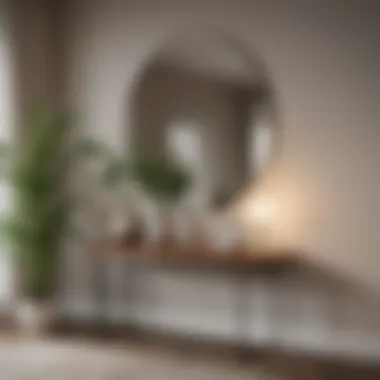
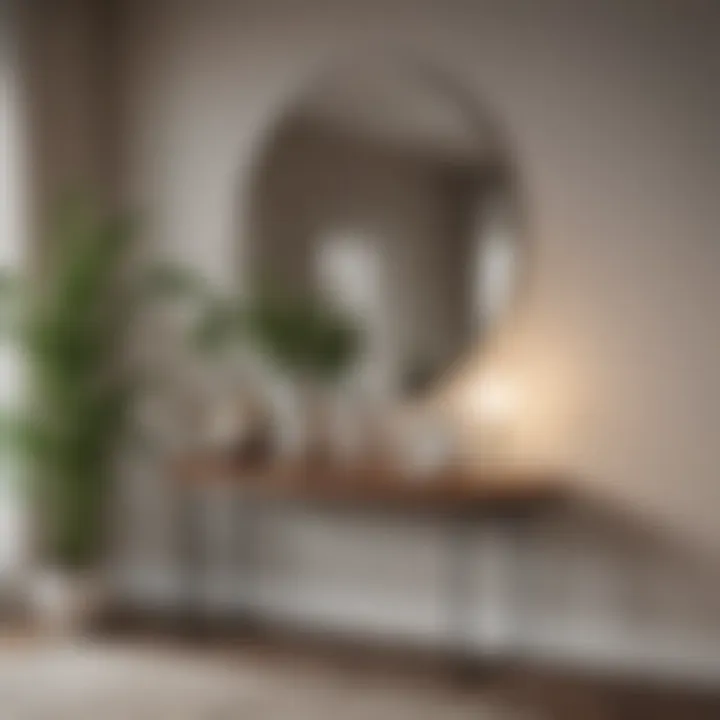
Intro
Rounded entryway tables are becoming an influential element in modern interior design. These tables serve not only as functional pieces but also as aesthetic focal points that set the tone for a home. The form and design of a rounded table can soften the overall space, offering a gentle transition from the outside world to the comfort of one's home. In this exploration, we take a detailed look at their design features, practical applications, and the overall impact on interior spaces.
Design Inspiration
Trending Styles
The appeal of rounded entryway tables lies in their versatility. They fit well across various design styles, from contemporary to traditional. Popular trends include minimalist designs, which emphasize sleek lines and neutral finishes. On the contrary, vintage-inspired pieces may showcase intricate carvings and rich wood textures. When selecting a style, consider how it interacts with existing decor elements. A glass-top rounded table can enhance an airy feeling in smaller spaces, while a more robust wooden version can provide warmth.
Color Palettes
Color plays a critical role in the selection of a rounded entryway table. Soft, muted hues tend to convey calmness, making them ideal for creating serene environments. Bold colors, however, can serve as striking centerpieces, adding personality to the entrance. Consider integrating colors that complement or contrast with the surrounding walls and furnishings. For instance, a dark navy table can create a stunning contrast against white walls, drawing attention while remaining sophisticated.
Practical Tips
Maintenance & Care
Maintaining a rounded entryway table requires some attention. Regular dusting can help preserve its finish. For wooden tables, gentle polishing with suitable products can protect against wear and tear. Glass tables, on the other hand, may require specific cleaners to avoid streaks. Always check the manufacturer's recommendations to ensure that you're using appropriate care techniques.
Budgeting & Planning
When planning for a rounded entryway table, budgeting is key. Prices can vary significantly based on materials and brands. Solid wood choices tend to be more expensive than laminate options but offer durability. Frame your search within your budget while also considering longevity. A well-thought-out investment can enhance your space for years to come. Think ahead about how the table will accommodate decor items, such as vases or decorative trays, which should also be included in your planning.
Rounded entryway tables are more than just furniture; they are gateways to your home's personality.
In summary, rounded entryway tables offer significant, multifaceted advantages in both design and functionality. Understanding these elements allows homeowners and design enthusiasts to make informed choices, contributing positively to their interior spaces.
Understanding Rounded Entryway Tables
When considering home decor, entryway tables often play a crucial role. They are not merely functional; they also embody style. Rounded entryway tables, in particular, stand out for their unique qualities. Understanding these tables offers insights into their design, utility, and aesthetic contributions to home environments.
Definition and Characteristics
Rounded entryway tables, by definition, are tables with circular or oval shapes designed for placement near an entrance. They usually possess a compact form, making them suitable for various spaces.
Key characteristics include:
- Shape: The rounded edges promote safety, particularly in homes with children or pets.
- Size: Typically smaller than rectangular tables, they fit snugly in tight corners or narrow hallways.
- Material: These tables can be crafted from wood, metal, or even glass, each providing a distinct look and feel.
Their dimensions, combined with their design, give homeowners a versatile furniture option that can enhance both functionality and aesthetics in any entryway.
Historical Context
The concept of the entryway table has evolved significantly over centuries. Originating in the 17th century, tables were initially used for functional purposes, such as placing keys or mail. However, as interior design trends shifted, these tables began to take on an aesthetic role as well.
Rounded designs became popular in the 18th and 19th centuries, often influenced by the artistic movements of the time. As more homeowners sought to blend utility with style, rounded entryway tables emerged as an ideal solution. They contributed to a sense of warmth and welcome in a home, which is vital for any entrance space.
Today, their relevance is clearer. In contemporary design, rounded entryway tables not only serve practical needs but also elevate the overall look of the home. They reflect the notion that even the smallest spaces can benefit from thoughtful design, making them indispensable in modern interiors.
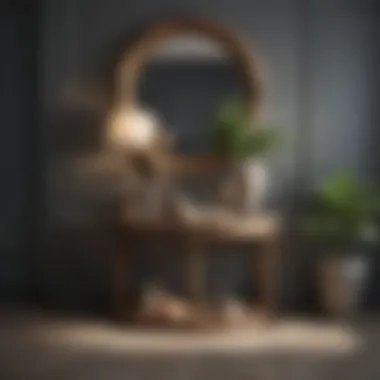

The Practical Functionality of Rounded Entryway Tables
Rounded entryway tables serve a functional role that extends beyond mere aesthetics. Their design and shape provide unique advantages, particularly in entrance spaces. These tables contribute significantly to the overall functionality of a home, making them essential for many homeowners and interior design enthusiasts. Understanding their practical uses is vital for anyone looking to enhance their entryway.
Utility in Small Spaces
One of the most compelling reasons to consider a rounded entryway table is their suitability for small spaces. Unlike rectangular tables, which can be bulky and obstructive, rounded tables offer a more compact footprint. This allows them to fit seamlessly into tighter areas where space is limited. Their curved edges reduce the risk of injury from sharp corners, making them safer for households with children or pets.
In addition to size, rounded tables create an illusion of space. They do not disrupt visual lines in a room as much as traditional tables might. This can be particularly beneficial in apartments or smaller homes where maximizing every inch is crucial. Thus, a rounded entryway table can enhance the spatial perception and promote a more open feel in smaller environments.
Enhancing Traffic Flow
Another vital function of rounded entryway tables is their ability to enhance traffic flow within a space. The smooth edges of these tables allow for easier movement. When placed in a hallway or near entry points, they facilitate an unobstructed passage, allowing residents and guests to navigate through without hassle.
In busy entryways, especially during gatherings or events, rounded entryway tables can serve a practical purpose. Their design encourages people to circulate around them rather than through them. This means that a rounded table can act as a subtle boundary, defining the entry area while ensuring the space remains accommodating.
Storage Solutions
Rounded entryway tables also provide valuable storage solutions. Their surface can hold essentials like keys, mail, or decorative items, keeping the entryway organized. Depending on the design, many rounded tables come with shelves or drawers, offering additional storage opportunities while maintaining an uncluttered look.
The inherent style of these tables often makes them a focal point. Adding decorative baskets can effectively utilize the storage space without compromising elegance. Such versatility allows homeowners to blend storage needs with aesthetic desires, ensuring that no area looks overly utilitarian.
Rounded entryway tables embody an intersection of style and practicality, proving that functionality does not have to be sacrificed for beauty.
Aesthetic Impact of Rounded Entryway Tables
The aesthetic impact of rounded entryway tables is significant in modern interior design. These tables serve not only as practical furniture pieces but also enhance the visual appeal of an entryway. They create a statement in the space where they are placed, influencing the first impressions of guests and residents alike. The design, color, and material choices play a crucial role in harmonizing the entryway with the rest of the home. Therefore, understanding how to select the right rounded entryway table can profoundly affect the overall decor and atmosphere.
Design Styles and Their Compatibility
Modern
In modern interior design, rounded entryway tables are valued for their simplicity and clean lines. A key characteristic of modern style is minimalism, which aims to reduce clutter and promote function over form. This design philosophy makes modern rounded tables a popular choice. They often feature sleek materials such as polished metal or smooth wood finishes. One unique feature of modern tables is their ability to blend seamlessly with other contemporary elements in a space. The advantages here include contributing to a spacious feel and providing a foundation for decorative items without overwhelming the area.
Traditional
Traditional design is marked by elegance and warmth. Rounded entryway tables often exhibit rich woods and intricate detailing. A characteristic of traditional style is its emphasis on craftsmanship and timeless appeal, making these tables a beneficial choice for homeowners seeking comfort and familiarity. The unique feature of traditional tables is their ornate legs or carvings that add a touch of sophistication. However, they may not fit well in overly minimalist designs, and this can limit their application in some modern contexts.
Transitional
The transitional style merges modern and traditional elements, resulting in versatile and adaptable designs. Rounded entryway tables in this style balance clean lines with traditional detail. This blend creates a cohesive look across varied interior styles, making transitional tables a desirable option. Their key characteristic is flexibility; thus, they can enhance rooms with different themes. A unique feature of transitional tables is their ability to adapt color and finish to complement existing decor. This flexibility, however, can be a disadvantage if not executed carefully, as poorly matched styles can lead to visual disarray.
Color and Material Choices
Wood
Wood is a staple in the construction of rounded entryway tables. Its natural warmth and variety of finishes make it a popular choice. A defining characteristic is its durability and timeless quality. The unique feature of wood tables is the visible grains, each telling a story of its own, making every piece unique. However, wood can be susceptible to scratches and require regular maintenance, which might be a consideration for some homeowners.
Metal
Metal in rounded entryway tables often offers a modern, industrial approach. Its key characteristics include strength and versatility in design, allowing for both lightweight and heavy-duty constructions. Metal tables often reflect a contemporary style, which is beneficial for modern decor themes. A unique feature of metal tables is the variety of finishes available, from brushed to polished. The disadvantage, however, could be that they may feel cold or uninviting due to their industrial nature, thus requiring careful styling to integrate warmth.

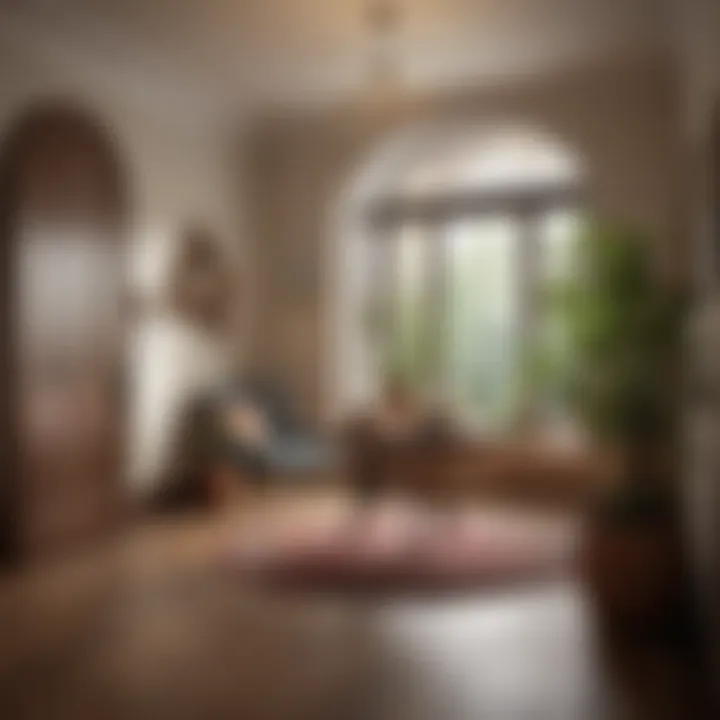
Glass
Glass tables bring an element of lightness and openness to entryways. Their main characteristic is transparency, which helps create an airy feeling in smaller spaces. This quality allows for the room's decor to flow visually while maintaining a minimal footprint. The unique feature of glass tables is the ability to showcase decorative items below or reflect light, enhancing the ambiance. However, glass can be fragile and may require careful handling and cleaning, which are considerations for potential buyers.
Rounded entryway tables not only fulfill functional roles but also elevate the aesthetic quality of an entrance, making thoughtful selection essential.
Selecting the Right Rounded Entryway Table
Choosing the appropriate rounded entryway table is crucial in achieving both functionality and aesthetic harmony in your home. A rounded entryway table serves practical needs while enhancing the overall look and feel of the space. This section explores the key aspects to consider in selection. Factors such as size, style, and compatibility with other decor are essential for ensuring a satisfactory match with your interior design goals.
Size Considerations
Height and Width
The height and width of a rounded entryway table significantly impact its usability and appearance. An ideal table should be proportionate to the space available, allowing for comfortable usage. Typical height ranges from 28 to 32 inches, accommodating average users without creating barriers within the entryway. Width varies, but a table that is too wide can hinder flow, while one that is too narrow may not serve its purpose effectively. Therefore, selecting a table that smoothly integrates with both the room and the users is beneficial.
One unique feature of height is its ability to dictate the table’s interaction with other furnishings. This is particularly relevant in smaller spaces. Opting for a lower table may encourage a more casual atmosphere. Conversely, a taller option can lend a sense of sophistication. Width, on the other hand, encourages spatial considerations, ensuring the piece does not dominate the entryway. Thus, careful consideration of these dimensions makes for a well-balanced and functional selection.
Proportions to Other Furniture
Understanding the proportions of the rounded table concerning other furniture pieces is another crucial factor. The correct proportions can harmonize the entryway’s look. If the table is too small relative to nearby furniture, it may feel lost in the space. Too large, however, can create an overwhelming sense of clutter.
A key characteristic to highlight is the need for visual balance. When choosing proportions, make sure the rounded table complements larger elements like benches or coat racks. This choice reflects a thoughtful design approach. A well-sized table aligned with adjacent furniture generates a seamless flow. It can also serve as a point of focus in an otherwise busy area.
Evaluating Style Fit
Alignment with Interior Design
Aligning the rounded entryway table with your overall interior design is vital. It can either unify or disrupt the space’s visual language, making your choice of design style critical. Whether modern, rustic, or classical, the table should enhance the existing decor.
A key characteristic is that each style has unique features to observe. For instance, a sleek, minimalist table fits an urban decor style, while a more ornate table complements a traditional setting. This alignment with interior design can serve as a conduit for visual storytelling within the home, enhancing the ambiance from the first point of entry.
The unique feature of alignment with style is its role in a cohesive design narrative. Patterns or materials that are used in furnishings or wall colors should resonate with the table's design. By ensuring that these elements work together, the home exudes a thoughtful and curated feel.
Compatibility with Decor Elements
The compatibility of the rounded entryway table with decor elements is another factor for selection. This includes wall art, lighting fixtures, and decorative accessories. A table that complements these features creates a multi-dimensional and engaging space.
One significant aspect of this compatibility is the ability of the table to function as a supporting player in the overall decor scheme. For example, if your lighting features are modern, a vintage table might feel out of place. Highlighting shared material choices can create unity. When a table’s finish or shape mirrors other decor, it enhances coherence in design. Such careful consideration can lead to harmonious interiors that are stylish while remaining functional.
Styling Tips for Rounded Entryway Tables
Styling rounded entryway tables involves thoughtful consideration of their design and placement. This aspect of the article emphasizes how styling can enhance the visual appeal while also reflecting the homeowner's personality. Effective styling can turn a simple piece of furniture into a statement that invites and impresses.
Creating a Welcoming Display
Using Personal Items
Using personal items on a rounded entryway table is a significant aspect in creating a warm atmosphere. The key characteristic of this approach lies in the personal touch it brings. These items can be photographs, souvenirs from travels, or even artworks. Each selection tells a story and makes the space feel more inviting. This choice often resonates well because it builds an emotional connection to the area, providing a sense of comfort to both residents and guests.
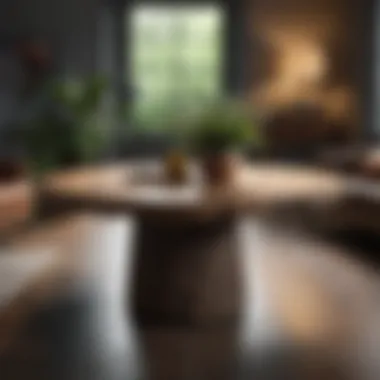
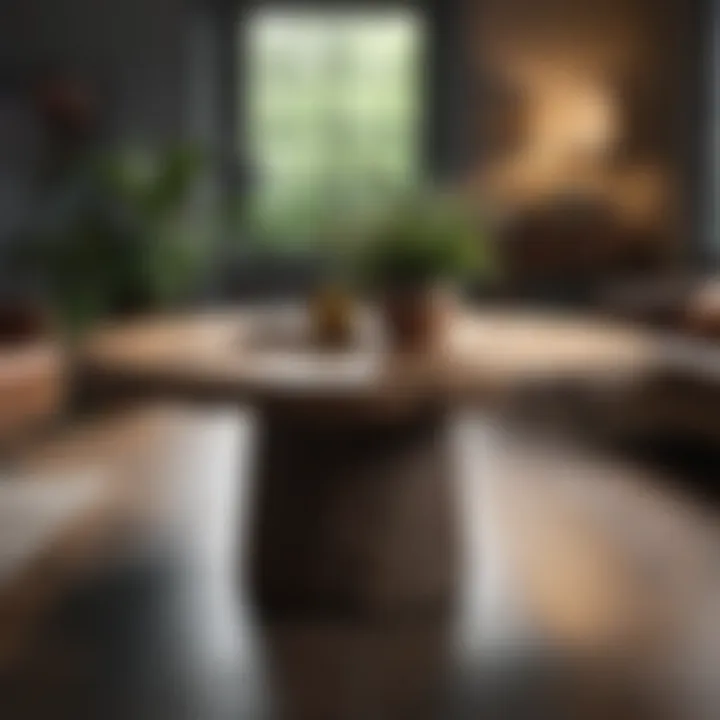
A unique feature of using personal items is their diversity. They can vary widely, so each arrangement conveys a distinct narrative. A benefit is that these items are readily available, thus reducing costs associated with home decor. However, an excessive accumulation may lead to clutter, so it is crucial to curate wisely.
Layering Textures
Layering textures is another essential styling tip that contributes positively to the overall aesthetic of the entryway table. It involves combining various items with different materials, such as wood, glass, and fabric. This method adds depth and visual interest to the arrangement.
The key characteristic of layering textures is its ability to create contrast. A smooth vase combined with a rough wooden tray, for instance, results in an eye-catching setup. This approach is beneficial because it engages the viewer's eye and can also reflect personal style preferences.
A unique feature of this technique is its adaptability. Different textures can easily be swapped out for seasonal changes. However, it is important to ensure that the layers do not overwhelm the table's surface. Achieving balance is critical in maintaining functionality while enhancing style.
Incorporating Lighting
Table Lamps
Incorporating table lamps on a rounded entryway table can dramatically improve both design and ambiance. The key characteristic of table lamps is their capacity to provide illumination, which helps to brighten up the entrance. Good lighting is crucial for safety, encouraging movement through the space effectively.
Using a table lamp is generally regarded as a beneficial choice as it elevates both functionality and style. A well-designed lamp can serve as a focal point, blending seamlessly with other decor. The unique feature of table lamps is the variety they come in — from minimalist to ornate designs. This flexibility allows homeowners to choose options that suit their taste. One downside could be that some may take up significant space, potentially limiting the area available for other decorative items.
Candle Arrangements
Candle arrangements offer a warm and inviting element when styling rounded entryway tables. Their key characteristic is the soft glow they emit, casting a cozy atmosphere in any space. Candles can create a serene feeling and are often associated with relaxation and welcome.
This option is popular among many decorators because it provides easy styling that can change with the seasons. You can use various shapes and sizes, making each display unique. A unique feature of candle arrangements is their ability to adapt to different themes — from rustic to elegant. However, one must be cautious about the fire hazard they pose, especially in high-traffic areas. It is essential to position them safely and avoid cluttering the table.
Addressing Common Challenges
In the journey of integrating rounded entryway tables into your space, several challenges may arise. Understanding these obstacles is essential not only for selecting the right piece but also for ensuring that it serves both aesthetic and functional purposes. This section will discuss the common challenges faced by homeowners and design enthusiasts when it comes to rounded entryway tables.
Space Limitations
Rounded entryway tables can be particularly advantageous in tight spaces, yet these same spaces often lead to significant challenges. The need for functionality may clash with the desire for a stylish addition. Here are some key points to consider:
- Measure Your Space: Always take precise measurements of the entryway. Consider height, width, and depth, ensuring adequate room for movement.
- Scaled Options: Opt for smaller or more streamlined designs that still retain visual appeal. A compact West Elm Round Entry Table can fit seamlessly into limited areas.
- Avoid Clutter: With limited space, it is vital to keep decorations and items minimal. Too many accessories can make the space feel cramped.
Maximizing the efficiency of space involves finding a table that balances elegance and practicality, allowing homeowners to enjoy both aesthetics and usability.
Balancing Style and Functionality
Integrating style and functionality is often where the magic happens, yet it is also a point of friction. It is crucial to ensure that the rounded entryway table does not compromise its utility for the sake of style. Here are considerations that can help achieve balance:
- Choose Versatile Designs: Look for tables that offer additional functionality, such as built-in storage solutions or adaptiveness in design. For instance, the IKEA HEMNES Console Table provides a stylish exterior with practical drawers.
- Material Selection: Prioritize materials that are both aesthetically pleasing and durable. This ensures that the table adds charm without sacrificing practical use over time. Wood, metal, and glass each have their pros and cons that affect durability and upkeep.
- Styling Options: When it comes to decorating the table, consider balance. Ensure decorations do not hinder the table's function. Items such as a simple vase or an attractive bowl can enhance the look without overwhelming the space.
"The essence of good design lies in the harmony of form and function. In entryways, this balance is especially notable."
Navigating these common challenges requires a mix of thoughtful consideration and creativity. Choosing the right rounded entryway table involves balancing the demands of space with stylistic desires. By proactively addressing these factors, you can create an entryway that is both inviting and practical.
Culmination
In the realm of interior design, particularly when addressing the function and form of entryways, rounded entryway tables have become essential. Their significance lies in the delicate balance they strike between style and purpose. These tables are not mere decorative accents; they serve as pivotal components of interior space management.
Recap of Key Points
In summary, rounded entryway tables offer numerous benefits for various interior styles. They aid in utility, especially in tight spaces where sharp edges can create hazards or hinder movement. Their versatility allows for a host of materials, from wood to glass, supporting different design preferences. The aesthetic appeal cannot be overstated, as they complement traditional, modern, and transitional styles alike. Moreover, making thoughtful selections regarding size, material, and overall design enhances their effectiveness.
Final Thoughts on Entryway Design
As we conclude our exploration of the rounded entryway table, it’s clear that these pieces embody much more than functionality. They represent an opportunity for individuals to showcase personal style while ensuring a smooth transition into the home. In selecting and styling a rounded entryway table, homeowners can transform an ordinary space into a welcoming entry point. Thoughtful design choices encourage a harmonious flow that sets the tone for the rest of the home. Thus, the rounded entryway table may be small in size but carries profound potential in interior design.















